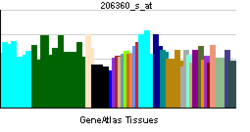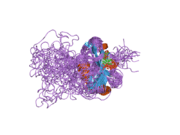SOCS3
| View/Edit Human | View/Edit Mouse |
Suppressor of cytokine signaling 3 (SOCS3 or SOCS-3) is a protein that in humans is encoded by the SOCS3 gene.[3][4] This gene encodes a member of the STAT-induced STAT inhibitor (SSI), also known as suppressor of cytokine signaling (SOCS), family. SSI family members are cytokine-inducible negative regulators of cytokine signaling.
Function
The expression of SOCS3 gene is induced by various cytokines, including IL6, IL10, and interferon (IFN)-gamma.
For signaling of IL-6, Epo, GCSF and Leptin, binding of SOCS3 to the respective cytokine receptor has been found to be crucial for the inhibitory function of SOCS3.
SOCS3 contributes to both leptin resistance and insulin resistance as a result of increased ceramide synthesis.[5] Because of that studies have shown that removal of the SOCS gene prevents against insulin resistance in obesity [6]
Studies of the mouse counterpart of this gene suggested the roles of this gene in the negative regulation of fetal liver hematopoiesis, and placental development.[7]
The SOCS3 protein can bind to JAK2 kinase, and inhibits the activity of JAK2 kinase.
Interactions
SOCS3 has been shown to interact with:
- Erythropoietin receptor,[8][9]
- Glycoprotein 130,[10]
- Insulin-like growth factor 1 receptor,[11]
- Janus kinase 2,[4][8][12]
- PTPN11,[10] and
- RAS p21 protein activator 1.[13]
Regulation
There is some evidence that the expression of SOCS3 is regulated by the microRNA miR-203.[14][15]
See also
References
- ↑ "Human PubMed Reference:".
- ↑ "Mouse PubMed Reference:".
- ↑ Minamoto S, Ikegame K, Ueno K, Narazaki M, Naka T, Yamamoto H, Matsumoto T, Saito H, Hosoe S, Kishimoto T (September 1997). "Cloning and functional analysis of new members of STAT induced STAT inhibitor (SSI) family: SSI-2 and SSI-3". Biochem Biophys Res Commun. 237 (1): 79–83. doi:10.1006/bbrc.1997.7080. PMID 9266833.
- 1 2 Masuhara M, Sakamoto H, Matsumoto A, Suzuki R, Yasukawa H, Mitsui K, Wakioka T, Tanimura S, Sasaki A, Misawa H, Yokouchi M, Ohtsubo M, Yoshimura A (November 1997). "Cloning and characterization of novel CIS family genes". Biochem Biophys Res Commun. 239 (2): 439–46. doi:10.1006/bbrc.1997.7484. PMID 9344848.
- ↑ Yang G, Badeanlou L, Bielawski J, Roberts AJ, Hannun YA, Samad F (2009). "Central role of ceramide biosynthesis in body weight regulation, energy metabolism, and the metabolic syndrome". American Journal of Physiology. 297 (1): E211–E224. doi:10.1152/ajpendo.91014.2008. PMC 2711669
 . PMID 19435851.
. PMID 19435851. - ↑ Jorgensen, Sebastian Beck; O'Neill, Hayley M.; Sylow, Lykke; Honeyman, Jane; Hewitt, Kimberly A.; Palanivel, Rengasamy; Fullerton, Morgan D.; Öberg, Lisa; Balendran, Anudharan (2013-01-01). "Deletion of skeletal muscle SOCS3 prevents insulin resistance in obesity". Diabetes. 62 (1): 56–64. doi:10.2337/db12-0443. ISSN 1939-327X. PMC 3526029
 . PMID 22961088.
. PMID 22961088. - ↑ "Entrez Gene: SOCS3 suppressor of cytokine signaling 3".
- 1 2 Sasaki A, Yasukawa H, Shouda T, Kitamura T, Dikic I, Yoshimura A (September 2000). "CIS3/SOCS-3 suppresses erythropoietin (EPO) signaling by binding the EPO receptor and JAK2". J. Biol. Chem. 275 (38): 29338–47. doi:10.1074/jbc.M003456200. PMID 10882725.
- ↑ Hörtner M, Nielsch U, Mayr LM, Heinrich PC, Haan S (May 2002). "A new high affinity binding site for suppressor of cytokine signaling-3 on the erythropoietin receptor". Eur. J. Biochem. 269 (10): 2516–26. doi:10.1046/j.1432-1033.2002.02916.x. PMID 12027890.
- 1 2 Lehmann U, Schmitz J, Weissenbach M, Sobota RM, Hortner M, Friederichs K, Behrmann I, Tsiaris W, Sasaki A, Schneider-Mergener J, Yoshimura A, Neel BG, Heinrich PC, Schaper F (January 2003). "SHP2 and SOCS3 contribute to Tyr-759-dependent attenuation of interleukin-6 signaling through gp130". J. Biol. Chem. 278 (1): 661–71. doi:10.1074/jbc.M210552200. PMID 12403768.
- ↑ Dey BR, Furlanetto RW, Nissley P (November 2000). "Suppressor of cytokine signaling (SOCS)-3 protein interacts with the insulin-like growth factor-I receptor". Biochem. Biophys. Res. Commun. 278 (1): 38–43. doi:10.1006/bbrc.2000.3762. PMID 11071852.
- ↑ Sasaki A, Yasukawa H, Suzuki A, Kamizono S, Syoda T, Kinjyo I, Sasaki M, Johnston JA, Yoshimura A (June 1999). "Cytokine-inducible SH2 protein-3 (CIS3/SOCS3) inhibits Janus tyrosine kinase by binding through the N-terminal kinase inhibitory region as well as SH2 domain". Genes Cells. 4 (6): 339–51. doi:10.1046/j.1365-2443.1999.00263.x. PMID 10421843.
- ↑ Cacalano NA, Sanden D, Johnston JA (May 2001). "Tyrosine-phosphorylated SOCS-3 inhibits STAT activation but binds to p120 RasGAP and activates Ras". Nat. Cell Biol. 3 (5): 460–5. doi:10.1038/35074525. PMID 11331873.
- ↑ Lena AM, Shalom-Feuerstein R, Rivetti di Val Cervo P, Aberdam D, Knight RA, Melino G, Candi E (2008). "miR-203 represses 'stemness' by repressing DeltaNp63.". Cell Death Differ. 15 (7): 1187–95. doi:10.1038/cdd.2008.69. PMID 18483491.
- ↑ Wei T, Orfanidis K, Xu N, Janson P, Ståhle M, Pivarcsi A, Sonkoly E (2010). "The expression of microRNA-203 during human skin morphogenesis.". Exp Dermatol. 19 (9): 854–6. doi:10.1111/j.1600-0625.2010.01118.x. PMID 20698882.
Further reading
- Yasukawa H, Sasaki A, Yoshimura A (2000). "Negative regulation of cytokine signaling pathways.". Annu. Rev. Immunol. 18: 143–64. doi:10.1146/annurev.immunol.18.1.143. PMID 10837055.
- Kile BT, Schulman BA, Alexander WS, Nicola NA, Martin HM, Hilton DJ (2002). "The SOCS box: a tale of destruction and degradation.". Trends Biochem. Sci. 27 (5): 235–41. doi:10.1016/S0968-0004(02)02085-6. PMID 12076535.
- Zhang JG, Farley A, Nicholson SE, Willson TA, Zugaro LM, Simpson RJ, Moritz RL, Cary D, Richardson R, Hausmann G, Kile BJ, Kent SB, Alexander WS, Metcalf D, Hilton DJ, Nicola NA, Baca M (1999). "The conserved SOCS box motif in suppressors of cytokine signaling binds to elongins B and C and may couple bound proteins to proteasomal degradation.". Proc. Natl. Acad. Sci. U.S.A. 96 (5): 2071–6. doi:10.1073/pnas.96.5.2071. PMC 26738
 . PMID 10051596.
. PMID 10051596. - Sasaki A, Yasukawa H, Suzuki A, Kamizono S, Syoda T, Kinjyo I, Sasaki M, Johnston JA, Yoshimura A (1999). "Cytokine-inducible SH2 protein-3 (CIS3/SOCS3) inhibits Janus tyrosine kinase by binding through the N-terminal kinase inhibitory region as well as SH2 domain.". Genes Cells. 4 (6): 339–51. doi:10.1046/j.1365-2443.1999.00263.x. PMID 10421843.
- Marine JC, McKay C, Wang D, Topham DJ, Parganas E, Nakajima H, Pendeville H, Yasukawa H, Sasaki A, Yoshimura A, Ihle JN (1999). "SOCS3 is essential in the regulation of fetal liver erythropoiesis.". Cell. 98 (5): 617–27. doi:10.1016/S0092-8674(00)80049-5. PMID 10490101.
- Schmitz J, Weissenbach M, Haan S, Heinrich PC, Schaper F (2000). "SOCS3 exerts its inhibitory function on interleukin-6 signal transduction through the SHP2 recruitment site of gp130.". J. Biol. Chem. 275 (17): 12848–56. doi:10.1074/jbc.275.17.12848. PMID 10777583.
- Ram PA, Waxman DJ (2000). "SOCS/CIS protein inhibition of growth hormone-stimulated STAT5 signaling by multiple mechanisms.". J. Biol. Chem. 274 (50): 35553–61. doi:10.1074/jbc.274.50.35553. PMID 10585430.
- Sasaki A, Yasukawa H, Shouda T, Kitamura T, Dikic I, Yoshimura A (2000). "CIS3/SOCS-3 suppresses erythropoietin (EPO) signaling by binding the EPO receptor and JAK2.". J. Biol. Chem. 275 (38): 29338–47. doi:10.1074/jbc.M003456200. PMID 10882725.
- Anhuf D, Weissenbach M, Schmitz J, Sobota R, Hermanns HM, Radtke S, Linnemann S, Behrmann I, Heinrich PC, Schaper F (2000). "Signal transduction of IL-6, leukemia-inhibitory factor, and oncostatin M: structural receptor requirements for signal attenuation.". J. Immunol. 165 (5): 2535–43. doi:10.4049/jimmunol.165.5.2535. PMID 10946280.
- Bjorbak C, Lavery HJ, Bates SH, Olson RK, Davis SM, Flier JS, Myers MG (2001). "SOCS3 mediates feedback inhibition of the leptin receptor via Tyr985.". J. Biol. Chem. 275 (51): 40649–57. doi:10.1074/jbc.M007577200. PMID 11018044.
- Shen X, Hong F, Nguyen VA, Gao B (2000). "IL-10 attenuates IFN-alpha-activated STAT1 in the liver: involvement of SOCS2 and SOCS3.". FEBS Lett. 480 (2–3): 132–6. doi:10.1016/S0014-5793(00)01905-0. PMID 11034314.
- Dey BR, Furlanetto RW, Nissley P (2001). "Suppressor of cytokine signaling (SOCS)-3 protein interacts with the insulin-like growth factor-I receptor". Biochem. Biophys. Res. Commun. 278 (1): 38–43. doi:10.1006/bbrc.2000.3762. PMID 11071852.
- Hartley JL, Temple GF, Brasch MA (2001). "DNA cloning using in vitro site-specific recombination". Genome Res. 10 (11): 1788–95. doi:10.1101/gr.143000. PMC 310948
 . PMID 11076863.
. PMID 11076863. - Cookson WO, Ubhi B, Lawrence R, Abecasis GR, Walley AJ, Cox HE, Coleman R, Leaves NI, Trembath RC, Moffatt MF, Harper JI (2001). "Genetic linkage of childhood atopic dermatitis to psoriasis susceptibility loci". Nat. Genet. 27 (4): 372–3. doi:10.1038/86867. PMID 11279517.
- Cacalano NA, Sanden D, Johnston JA (2001). "Tyrosine-phosphorylated SOCS-3 inhibits STAT activation but binds to p120 RasGAP and activates Ras". Nat. Cell Biol. 3 (5): 460–5. doi:10.1038/35074525. PMID 11331873.
- Roberts AW, Robb L, Rakar S, Hartley L, Cluse L, Nicola NA, Metcalf D, Hilton DJ, Alexander WS (2001). "Placental defects and embryonic lethality in mice lacking suppressor of cytokine signaling 3". Proc. Natl. Acad. Sci. U.S.A. 98 (16): 9324–9. doi:10.1073/pnas.161271798. PMC 55419
 . PMID 11481489.
. PMID 11481489. - Dif F, Saunier E, Demeneix B, Kelly PA, Edery M (2001). "Cytokine-inducible SH2-containing protein suppresses PRL signaling by binding the PRL receptor". Endocrinology. 142 (12): 5286–93. doi:10.1210/endo.142.12.8549. PMID 11713228.
- Bode JG, Ludwig S, Freitas CA, Schaper F, Ruhl M, Melmed S, Heinrich PC, Häussinger D (2002). "The MKK6/p38 mitogen-activated protein kinase pathway is capable of inducing SOCS3 gene expression and inhibits IL-6-induced transcription". Biol. Chem. 382 (10): 1447–53. doi:10.1515/BC.2001.178. PMID 11727828.



